Like a comet had crashed
Mati, Greece -- When wildfires began devouring the coastal resort of Mati in July, eventually killing 91 people in the deadliest fire in Greece's history, I was among the first journalists on the scene.
 This photo taken on July 23, 2018 shows a road block as a wildfire burns in Kineta, near Athens. (AFP / Angelos Tzortzinis)
This photo taken on July 23, 2018 shows a road block as a wildfire burns in Kineta, near Athens. (AFP / Angelos Tzortzinis)I am no stranger to death and suffering -- in my line of work I have covered war and the migrant crisis and have seen my share of human misery. But the deadly blaze became the most traumatic assignment of my career.
 Flames rise as a wildfire burns in the town of Rafina, near Athens, on July 23, 2018. (AFP / Angelos Tzortzinis)
Flames rise as a wildfire burns in the town of Rafina, near Athens, on July 23, 2018. (AFP / Angelos Tzortzinis)When the fire broke out on July 23, I had been following another fire west of Athens at Kineta. When I heard about the blaze at Mati 80 kilometers to the east, I headed out there, eventually reaching the town in the early evening.
It was utter chaos. Like a comet had crashed.
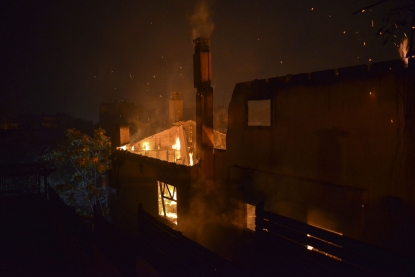 A house burns as a wildfire rages at the village of Mati, near Athens on July 23, 2018. (AFP / Angelos Tzortzinis)
A house burns as a wildfire rages at the village of Mati, near Athens on July 23, 2018. (AFP / Angelos Tzortzinis)There were pockets of fire burning, but it was mostly dark as the power had gone out.
On the road ahead, I saw a cameraman filming. I took advantage of his camera light to shoot a few pictures, very quickly. At first, I hadn't fully realised what it was I had photographed.
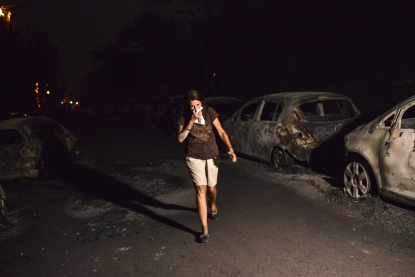 A woman walks in front of burnt cars at the village of Mati during a wildfire near Athens, on July 23, 2018. (AFP / Angelos Tzortzinis)
A woman walks in front of burnt cars at the village of Mati during a wildfire near Athens, on July 23, 2018. (AFP / Angelos Tzortzinis) Two women evacuate the village of Mati during a wildfire near Athens, on July 23, 2018. (AFP / Angelos Tzortzinis)
Two women evacuate the village of Mati during a wildfire near Athens, on July 23, 2018. (AFP / Angelos Tzortzinis)
Then I saw the charred bodies under a car. Two of them, entwined. The police later said there was also a child there. I did not see it.
Another body was just bones and a bit of flesh. The smell of burnt flesh was unbearable.
There were other burnt people in the cars but at the time it didn't register with me. I only realised it later while sending the photos.
 This photo taken on July 24, 2018 show cars burnt following a wildfire at the village of Mati, near Athens, on July 24, 2018. (AFP / Angelos Tzortzinis)
This photo taken on July 24, 2018 show cars burnt following a wildfire at the village of Mati, near Athens, on July 24, 2018. (AFP / Angelos Tzortzinis)The fire was so intense, it melted everything in its path. Molten metal from the cars was flowing on the street. The soles of my shoes were melting too.
I could hear loud bangs -- the sounds of car batteries exploding.
 A woman with a cast stands among cars burnt following a wildfire at the village of Mati, near Athens, on July 24, 2018. (AFP / Angelos Tzortzinis)
A woman with a cast stands among cars burnt following a wildfire at the village of Mati, near Athens, on July 24, 2018. (AFP / Angelos Tzortzinis)Electric pylons had fallen. I had to crawl beneath one to reach a small bay where people had taken refuge, following the sound of their cries. I only had the flashlight on my phone to light my way. It was like a science fiction film.
On the beach I took pictures of people being rescued by small fishing boats. All the time I was there, there wasn't a single coastguard of navy vessel. It was shocking. At one point I realised that I had stopped taking pictures and was just watching the scene unfold.
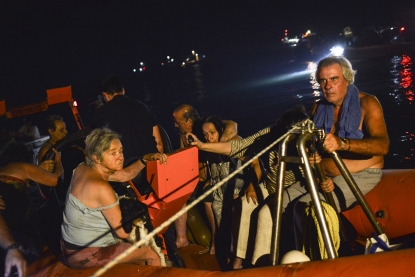 Rescuers and volunteers help local people evacuate the village of Mati during a wildfire near Athens, on July 23, 2018. (AFP / Angelos Tzortzinis)
Rescuers and volunteers help local people evacuate the village of Mati during a wildfire near Athens, on July 23, 2018. (AFP / Angelos Tzortzinis)I was alone, under pressure, totally confused by what was happening. From a practical viewpoint, it was impossible to file because the internet connection was down too. I worked like a robot, not thinking. The only thing I wanted was a connection to send my pictures.
I let the bureau know the true scope of the disaster. Up until then, officials were talking about a single casualty.
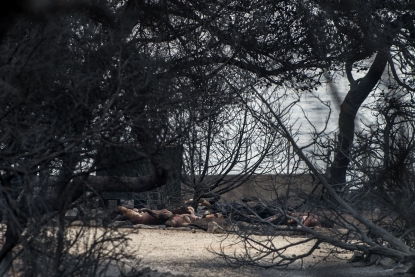 This photo taken on July 24, 2018 show dead people following a wildfire at the village of Mati, near Athens, on July 24, 2018. (AFP / Angelos Tzortzinis)
This photo taken on July 24, 2018 show dead people following a wildfire at the village of Mati, near Athens, on July 24, 2018. (AFP / Angelos Tzortzinis)The following morning I was on edge, tired, everything was swirling in my head. I hadn't slept for a day but I still could not stay idle.
The official death toll was 24, but one TV station was talking about a 'horrible thing that cannot be cited yet'. It was the discovery of 26 people in the yard of a villa, just next to the sea.
The bodies were found in groups, locked in embrace. Undoubtedly they had panicked and lost their way. They wanted to reach the beach but the property stood above a cliff. I had photographed them from afar. In any case we were not allowed by the authorities to get any closer, and even then I'm not sure I would have approached.
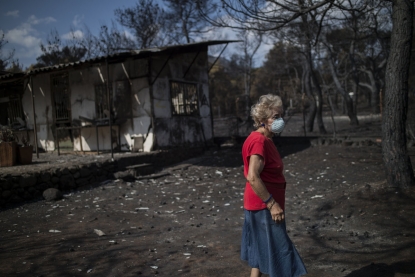 A woman wearing a mask walks in front of her burnt house following a wildfire at the village of Neos Voutzas, near Athens, on July 26, 2018. (AFP / Angelos Tzortzinis)
A woman wearing a mask walks in front of her burnt house following a wildfire at the village of Neos Voutzas, near Athens, on July 26, 2018. (AFP / Angelos Tzortzinis)This fire is the worst thing I've ever seen on the job. I've never seen a disaster such as this.
I've been to war zones, seen people killed in bombardments. I've also seen terrible things while covering the migrant crisis.
But to see an entire village wiped out, in the 21st century. It's my own country too, which makes it even more distressing. Words are not enough to describe what I saw.
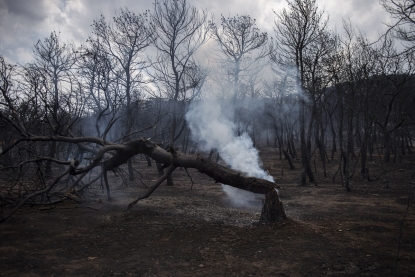 A photo shows a view of a burnt forest following a wildfire in the village of Neos Voutzas, near Athens, on July 24, 2018. (AFP / Angelos Tzortzinis)
A photo shows a view of a burnt forest following a wildfire in the village of Neos Voutzas, near Athens, on July 24, 2018. (AFP / Angelos Tzortzinis)It was only on the third day that I began to realise what had happened.
The fire was very unpredictable. I took a picture of a bouquet of flowers placed at the fence of a house, in homage to a family that died there. There were still pieces of bone below the bouquet, left over when the rescuers removed the bodies. But after killing these people, the fire cruelly changed direction, and their house was spared. That's what a neighbor told me.
 A picture taken on July 26, 2018 shows flowers on a fence of a house where two bodies where found following a wildfire at the village of Mati, near Athens. (AFP / Angelos Tzortzinis)
A picture taken on July 26, 2018 shows flowers on a fence of a house where two bodies where found following a wildfire at the village of Mati, near Athens. (AFP / Angelos Tzortzinis)I continued to take pictures until the fourth day, July 26, including some of damaged properties, to help the owners claim compensation.
On the fifth day, I didn't go back. But I still woke up at five in the morning. I needed to rest for a few days.
There is the question of what photos we are allowed to send for a disaster of this magnitude. Photographing the dead is part of my job. But I try to do it with respect.
On the first night out, I sent just one photo of a charred body under a car. You could not see much. I thought this was enough to show what was happening.
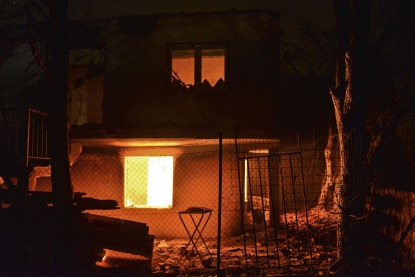 A house burns during a wildfire at the village of Mati, near Athens on July 23, 2018. (AFP / Angelos Tzortzinis)
A house burns during a wildfire at the village of Mati, near Athens on July 23, 2018. (AFP / Angelos Tzortzinis)Then we decided with the photo chief in Athens in Paris that I should send more and that the desk in Paris would decide what to put out on the wire.
It's a fine balance between ethics, respect for the dead, and public information. It is important for people to have an idea of what happened.
I think in situations like this, the photographer on the ground should send everything he shoots. And the people on the desk, who are more detached, should decide what to send on to clients.
It's my job to show pictures of bodies, of course, but what interests me is to show viewers another aspect, to take a certain distance.
For example, my favourite image is one I took on the hill above Mati early that first evening. A father looking at the blaze in the distance, his child in his arms.
 People watch a wildfire in the town of Rafina, near Athens, on July 23, 2018. (AFP / Angelos Tzortzinis)
People watch a wildfire in the town of Rafina, near Athens, on July 23, 2018. (AFP / Angelos Tzortzinis)This blog was written with Odile Duperry in Athens.


